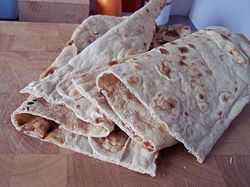Chapati
| Chapati | |
|---|---|
|
Plain chapati and stuffed rolled chapatis | |
| Alternative names | Roti/Poli |
| Type | Flatbread |
| Region or state | South Asia, Central Asia, Horn of Africa, East Africa |
| Main ingredients | Flour |
|
| |
Chapati (alternately Chapatti, Chappati or Chapathi) is an unleavened flatbread (also known as roti) from Sri Lanka, India, Nepal, Bangladesh and Pakistan.[1] It is a common staple in South Asia as well as amongst South Asian expatriates throughout the world. Versions of the dish are also found in Central Asia and the Horn of Africa, with the laobing flatbread serving as a local variation in China. Chapati is known as sapati or doday in the Pashto language.
History
The word 'Chapati' means "flattened round" in Indian languages . Chapati is noted in Ain-i-Akbari, a 16th-century document, by Mughal Emperor, Akbar’s vizier, Abu'l-Fazl ibn Mubarak.[1]
Chapatis are one of the most common forms in which wheat, the staple of northern and western India, is consumed. Chapati is a form of 'Roti or rotta (bread). The words are often used interchangeably. Chapati or Roti is made of whole wheat flour and cooked on a tava (flat skillet).
Cooking

Chapatis are made from a firm dough made from flour (whole grain common wheat), 'Atta' in Hindi/Urdu/Punjabi/Nepali/Bengali, and water. Atta flour is more finely ground than most western-style whole wheat flours. Some people also add salt or oil to the dough. Small portions of the dough are rolled out into discs much like a tortilla, using a rolling pin. The rolled-out dough is thrown on the preheated dry tava (griddle or skillet) and cooked on both sides. In some regions of Nepal and western India they are only partly cooked on the skillet, and then put directly on a high flame, which makes them blow up like a balloon. The hot air cooks the chapati rapidly from the inside. In some parts of northern India (e.g. Punjab) and Pakistan, this is called a phulka (that which has been inflated).
In Konkan, chapati is also called poli. Poli is slightly thicker than phulka and contains four layers and oil or pure ghee is applied after cooking. The poli will remain soft throughout the day.
During festivals, a sweet poli with stuffing, made with gram flour (besan) and sugar or jaggery, is prepared, called 'PuranPoli'. During Sankranti, a thin sweet poli stuffed with jaggery called 'Gud Poli' is prepared.

Often, the top of a chapati is slathered with butter or ghee (clarified butter). A piece of chapati is torn off and used to pick up the meat or vegetable dish(es) that make the meal.

Chapati sizes (diameter and thickness) vary from region to region and kitchen to kitchen. In Gujarat, for example, the chapati is called a 'rotli' and can be as thin as tissue paper. Chapatis made in domestic kitchens are usually not larger than 6–7 inches in diameter since the 'tava' on which they are made comes in sizes that fit comfortably on a domestic stove top. Tavas were traditionally made of unglazed earthenware, but are now typically made from metal. There are also electric tavas manufactured in Nepal and India. The shape of the rolling pin also varies from region to region. Some households simply use a kitchen work top as a sort of pastry board, but homes have round flat-topped 'boards' that may be made of wood or stone, specifically for rolling out chapatis.

Flat unleavened breads in South Asia come in many forms; the chapati is only one of them. A rotta, made of a dough similar to that used to make chapatis and cooked in an oven, is a 'tandoori roti'. The combination of wheat flour with one or more flours (e.g. chickpea, maize, or millet) will produce a "missi roti". Rottas made with pearl millet (Bajra) or Maize (makka) or Jowar flour usually carry the name of the flour, as in "bajra roti" or "makke ki roti" (or "bhakri" in Marathi). Flat breads such as chapati and roti are traditionally a food of northern South Asia. The peninsular south, the east and northeast and Kashmir are primarily rice-eating cultures.

In most parts of India, there is a distinction made between a 'chapati' and its layered version, the 'paratha'. 'Parathas' are either made layered by spreading with ghee or oil folding and rolling out again into a disc, or else have a filling, such as spinach, dal (lentils) cooked radish, or potato. Parathas are mostly made using all-purpose flour instead of whole wheat flour. There is a newwer version called 'Tandoori Roti' which is thick like the Paratha- and made using whole wheat flour.
There are many modern varieties of chapati in India.
- Paneer chapati: Grated Paneer is added to the usual chapati dough
- Radish or Mullangi chapati: Grated radish and turmeric powder is added to the dough and the chapati is usually thick. It is often eaten by lorry drivers who eat in roadside dhabas during their long journey to some other state.
- Vegetable stuffed chapati: In this type of chapati, a gravy of carrot, potato, peas, fenugreek are mashed and slightly sauted into a masala gravy. It is usually given rolled and many households prepare this using their own variety and combinations of available vegetables.
In the Maldives, chapati are traditionally eaten for breakfast along with a dish known as mas huni.[2]
See also
References
- ↑ 1.0 1.1 Of Bread Ain-i-Akbari , by Abu'l-Fazl ibn Mubarak. English tr. by Heinrich Blochmann and Colonel Henry Sullivan Jarrett, 1873–1907. The Asiatic Society of Bengal, Calcutta, Volume I, Chap. 26, page 61.
- ↑ Xavier Romero-Frias, The Maldive Islanders, A Study of the Popular Culture of an Ancient Ocean Kingdom, Barcelona 1999, ISBN 84-7254-801-5
| Wikimedia Commons has media related to Chapati. |
| Wikibooks Cookbook has a recipe/module on |
| ||||||||||||||
| ||||||||||||||||||||||||||||||||||||||||||||||||||||||
| ||||||||||||||
| |||||||||||||||||||||||||
| ||||||||||||||||||||||||||||||||||||||||||





